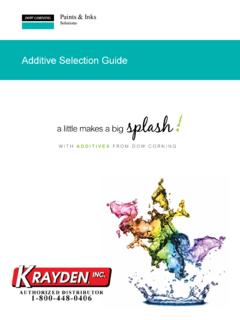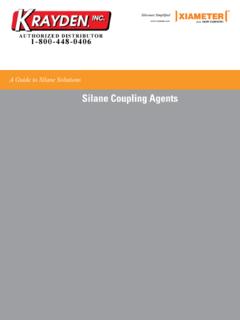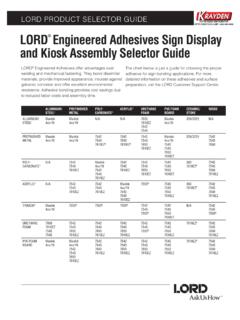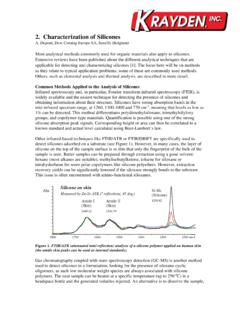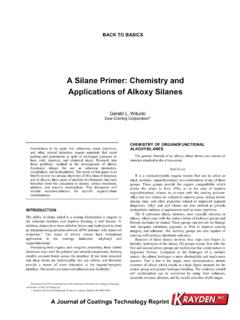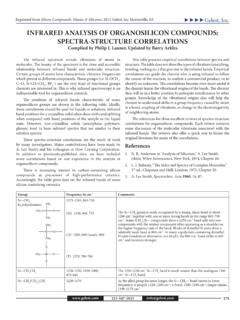Transcription of Silane Coupling Agents - Krayden
1 Silane Coupling AgentsA Guide to Silane SolutionsThe Concept of Coupling with Organofunctional SilanesSilane Coupling Agents ilane Coupling Agents are silicon-based chemicals that contain two types of reactivity inorganic and organic in the same molecule. A typical general structure is(RO)3 SiCH2CH2CH2-X, where RO is a hydrolyzable group, such as methoxy, ethoxy, or acetoxy , and X is an organofunctional group, such as amino, methacryloxy, epoxy, etc. A Silane Coupling agent will act at an interface between an inorganic substrate (such as glass, metal or mineral) and an organic material (such as an organic polymer, coating or adhesive) to bond, or couple, the two dissimilar materials.
2 A simplified picture of the Coupling mechanism is shown in Figure 1. The Silane Coupling 2. SEM of silica-filled epoxy Fiberglass Fillers Metals Organic Rubber Polymers Plastics SiWithout Silane With Silane during composite aging and use. The Coupling agent provides a stable bond between two otherwise poorly bonding surfaces. Figure 2 shows (via an SEM of the fracture surface) the difference in adhesion between a silica-filled epoxy resin with Silane vs. without Silane . With Silane , the epoxy coating on the silica particles is apparent; without Silane , clean silica particles can be seen in the epoxy matrix.
3 In composites, a substantial increase in flexural strength is possible through the use of the right Silane Coupling agent . Silane Coupling Agents also increase the bond strength of coatings and adhesives as well as their resistance to humidity and other adverse environmental conditions. Other benefits Silane Coupling Agents can provide include: Better wetting of inorganic substrates Lower viscosities during compounding Smoother surfaces of composites Less catalyst inhibition of thermoset composites Clearer reinforced plastics The Silane Bond to the Inorganic Substrate Silane Coupling Agents that contain three inorganic reactive groups on silicon (usually methoxy, ethoxy or acetoxy ) will bond well to the metal hydroxyl groups on most inorganic substrates, especially if the sub-strate contains silicon, alumi-num or a heavy metal in its struc-ture.
4 The alkoxy groups on silicon hydrolyze to silanols, either through the addition of water or from residual water on the inorganic surface. Then the silanols coordi-nate with metal hydroxyl groups on the inorganic surface to form an oxane bond and eliminate water. See Figures 3 and 4. Why Silane Coupling Agents Are UsedWhen organic polymers are re- inforced with glass fibers or miner-als, the interface, or interphase region, between the polymer and the inorganic substrate is involved in a complex interplay of physical and chemical factors. These factors are related to adhesion, physical strength, coefficient of expansion, concentration gradients and reten-tion of product properties.
5 A very destructive force affecting adhe-sion is migration of water to the hydrophilic surface of the inorganic reinforcement. Water attacks the interface, destroying the bond between the polymer and reinforce-ment, but a true Coupling agent creates a water-resistant bond at the interface between the inor-ganic and organic materials. Silane Coupling Agents have the unique chemical and physical properties not only to enhance bond strength but also, more importantly, to prevent de-bonding at the interface Figure 3. Hydrolysis of 4. Bonding to an inorganic RSi(OCH3) 3 RSi(OH) 3H2OH2O HO-Si-O-Si-O-Si-OHRRROOOHHHOOO RRRRRROHHHHHHOOHOSiSiSiOOOH OOOHOSiSiSiOOOHH2 Oamino- Silane will bond to an epoxy resin; an aminosilane will bond to a phenolic resin; and a methacrylate Silane will bond through styrene crosslinking to an unsaturated polyester resin.
6 With thermoplastic polymers, bonding through a Silane Coupling agent can be explained by inter-diffusion and inter-penetrating network (IPN) formation in the interphase region. See Figure 5. To optimize IPN formation, it is important that the Silane and the resin be compatible. One method is to match the chemical character-istics of the two materials. This will help improve the chances of form-ing a good composite with optimum properties. Even with thermoset polymers, where reactivity plays an important role, chemical structure matching will enhance the physical properties of the composite.
7 How to Choose a Silane Coupling AgentAll Silane Coupling Agents with three OR groups on silicon should bond equally well with an inorganic substrate. The XIAMETER brand product line includes a variety of organofunctional alkoxysilanes. See Figure the organofunctional group on silicon with the resin poly-mer type to be bonded will dictate which Silane Coupling agent should be used in a particular application. The organic group on the Silane can be either a reactive organic group ( , an organofunctional group), or it can be a non-reactive organic group. The groups can be hydro-phobic or hydrophilic, with varying thermal stability characteristics.
8 Silane molecules also react with each other to give a multimolecular structure of bound Silane Coupling agent on the surface. More than one layer, or monolayer equiva-lents, of Silane is usually applied to the surface. This results in a tight siloxane network close to the inor-ganic surface that becomes more diffuse away from the Silane Bond to the PolymerThe bond to the organic polymer is complex. The reactivity of a ther- moset polymer should be matched to the reactivity of the Silane . For example, an epoxysilane or Figure 5. The inter-penetrating network (IPN) bonding Polymer Coupling agent ChemicallyBonded InterfaceDiffuse InterphaseTable 1.
9 Characteristics of Various Organic Substituents on SilanesOrganosilanes R-Si(OMe)3 RCharacteristics of R MeHydrophobic, OrganophilicPhHydrophobic, Organophilic, Thermal Stabilityi-Bu Hydrophobic, OrganophilicOctyl Hydrophobic, Organophilic-NH(CH2) 3NH2 Hydrophilic, OrganoreactiveEpoxy Hydrophilic, OrganoreactiveMethacryl Hydrophobic, Organoreactive SiROR'OR'R' OSiCHCH2 MeOOMeMeOOFS-6300 OFS-6040 SiOOMeMeOMeOOCH3CH2 OFS-6030 SiEtOEtOOEtOFS-6341 SiNH2 EtOEtOOEtOFS-6011 Basic StructureR = alkyl, aryl, or organofunctional groupOR' = methoxy, ethoxy, or acetoxy SiOOMeMeOMeOOFigure 6.
10 Silane Coupling agent variations basic solubility parameters of the groups will vary, depending on the organic structure; this will influence, to some extent, the interpenetration the polymer network will have into the siloxane network of the surface treatment. Table 1 lists some of the characteristics for common organic substituents attached to silicon. The choice of Silane should involve matching chemical reactivity, solubility characteristics, structural characteristics and, possibly, the thermal stability of the organosilane with the same parameters in the polymer brand SilaneOrganic GroupAlkoxy GroupChemical NameOFS-6697-EthoxyTetraEthoxysilaneOFS- 6070 MethylMethoxyMethyltrimethoxysilaneOFS-6 366 MethylMethoxyMethyltrimethoxysilane (HP)OFS-6370 MethylEthoxyMethyltriethoxysilaneOFS-638 3 MethylEthoxyMethyltriethoxysilane (HP)
